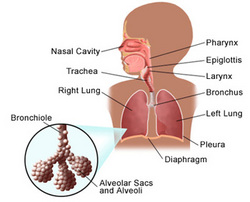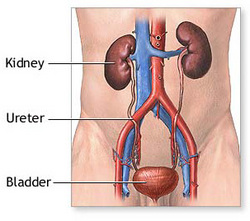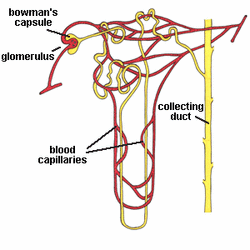Chapter 20
The Respiratory System

Courtesy of Generic Look Medical Encyclopedia
We need to breathe air to live. Oxygen is a gas that makes up 21% of air.
Breathing is the movement of the chest that brings air into the lungs and removes waste gases. The oxygen in the lungs is exchanged for carbon dioxide and waste gases in the blood. The blood takes the oxygen to body cells. At the same time, glucose is being transported to the cells by the digestive system. Oxygen is used to break down glucose. This releases energy as well as carbon dioxide and excess water. This process is called cellular respiration.
The chemical equation is as follows: Glucose + Oxygen ==> Energy + Carbon Dioxide + Water.
The respiratory system"s function is to bring oxygen to the body and remove carbon dioxide. There are many different structures of the body air must go through for the respiratory system's function to be complete.
1) Nose or mouth
2) Nasal cavity- this is where air is warmed, moistened, and filtered.
3) Pharynx
4) Larynx
5)Trachea
6) Bronchi
7) Bronchioles
8) Alveoli
The exchange of oxygen takes place between capillaries in the lungs and the alveoli (tiny, thin walled air sacs at the end of bronchioles).
The diaphragm is a muscle beneath your lungs. It helps you to breathe. When you inhale, the diaphragm contracts, pushing up on the lungs. This cause the lungs to expand to allow the air to fit. When you exhale, the relaxes, allowing the volume of the lungs to decrease. Without the diaphragm, you would not be able to breathe.
One addiction that is very harmful to your respiratory system is smoking. Tobacco contains nicotine and tar. These substances destroy cells and harm your respiratory organs. Smoking increases the risk of many diseases like lung cancer, chronic bronchitis (swelling of bronchial tubes), emphysema (breaking down of the alveoli), and heart disease.
Breathing is the movement of the chest that brings air into the lungs and removes waste gases. The oxygen in the lungs is exchanged for carbon dioxide and waste gases in the blood. The blood takes the oxygen to body cells. At the same time, glucose is being transported to the cells by the digestive system. Oxygen is used to break down glucose. This releases energy as well as carbon dioxide and excess water. This process is called cellular respiration.
The chemical equation is as follows: Glucose + Oxygen ==> Energy + Carbon Dioxide + Water.
The respiratory system"s function is to bring oxygen to the body and remove carbon dioxide. There are many different structures of the body air must go through for the respiratory system's function to be complete.
1) Nose or mouth
2) Nasal cavity- this is where air is warmed, moistened, and filtered.
3) Pharynx
4) Larynx
5)Trachea
6) Bronchi
7) Bronchioles
8) Alveoli
The exchange of oxygen takes place between capillaries in the lungs and the alveoli (tiny, thin walled air sacs at the end of bronchioles).
The diaphragm is a muscle beneath your lungs. It helps you to breathe. When you inhale, the diaphragm contracts, pushing up on the lungs. This cause the lungs to expand to allow the air to fit. When you exhale, the relaxes, allowing the volume of the lungs to decrease. Without the diaphragm, you would not be able to breathe.
One addiction that is very harmful to your respiratory system is smoking. Tobacco contains nicotine and tar. These substances destroy cells and harm your respiratory organs. Smoking increases the risk of many diseases like lung cancer, chronic bronchitis (swelling of bronchial tubes), emphysema (breaking down of the alveoli), and heart disease.
The Excretory System

Courtesy of Renavive
The excretory system is made of many body systems that all, in some way, get rid of wastes.
1) Digestive system- releases undigested food as feces
2) Respiratory system- releases carbon dioxide and water through exhaling
3) Skin- releases salt, water, and other organic substances as sweat
4) Urinary system- releases water, salts, and metabolic wastes through urine
The urinary system rids the blood of wastes. The major organs of the urinary system are the kidneys (filter blood that contains wastes from cells). The steps to filtration of the blood are as follows:
1) Blood enters the kidney through the renal artery.
2) The renal artery separates into arterioles and capillaries.
3) The capillaries enter the nephron (tiny, filtering unit of the kidney, in picture below).
4) The capillaries form a tight coil called the glomerulus. This is where filtration of wastes and excess salts, water, and sugar from blood occurs.
5) The blood moves through the proximal and distal convoluted tubules (yelow tubes in picture). Here, most water, salts, and sugars are reabsorbed into the blood.
Blood:
6) The blood then moves through the renal vein.
7) Next it moves through the inferior vena cava.
8) Finally the blood reaches the heart to be pumped throughout the body again.
Wastes:
6) The wastes then move through the loop of henle (the loop at the bottom of the nephron).
7) The wastewater, or urine, drains into the collecting duct of the nephron.
8) Urine from every nephron in the kidney dumps into the renal pelvis.
9) From here, urine enters the ureters.
10) The ureters carry urine from the kidney to the urinary bladder.
11) Urine in the urinary bladder flows into the urethra.
12) The urethra moves urine out of the body.
You can live with one kidney. When neither of your kidneys work, though, you must undergo a treatment called dialysis. About three times a week for six hours at a time, you are hooked up to an artificial kidney machine. This machine, called dialysis, acts as your kidneys to filter all of the blood in your body.
1) Digestive system- releases undigested food as feces
2) Respiratory system- releases carbon dioxide and water through exhaling
3) Skin- releases salt, water, and other organic substances as sweat
4) Urinary system- releases water, salts, and metabolic wastes through urine
The urinary system rids the blood of wastes. The major organs of the urinary system are the kidneys (filter blood that contains wastes from cells). The steps to filtration of the blood are as follows:
1) Blood enters the kidney through the renal artery.
2) The renal artery separates into arterioles and capillaries.
3) The capillaries enter the nephron (tiny, filtering unit of the kidney, in picture below).
4) The capillaries form a tight coil called the glomerulus. This is where filtration of wastes and excess salts, water, and sugar from blood occurs.
5) The blood moves through the proximal and distal convoluted tubules (yelow tubes in picture). Here, most water, salts, and sugars are reabsorbed into the blood.
Blood:
6) The blood then moves through the renal vein.
7) Next it moves through the inferior vena cava.
8) Finally the blood reaches the heart to be pumped throughout the body again.
Wastes:
6) The wastes then move through the loop of henle (the loop at the bottom of the nephron).
7) The wastewater, or urine, drains into the collecting duct of the nephron.
8) Urine from every nephron in the kidney dumps into the renal pelvis.
9) From here, urine enters the ureters.
10) The ureters carry urine from the kidney to the urinary bladder.
11) Urine in the urinary bladder flows into the urethra.
12) The urethra moves urine out of the body.
You can live with one kidney. When neither of your kidneys work, though, you must undergo a treatment called dialysis. About three times a week for six hours at a time, you are hooked up to an artificial kidney machine. This machine, called dialysis, acts as your kidneys to filter all of the blood in your body.

